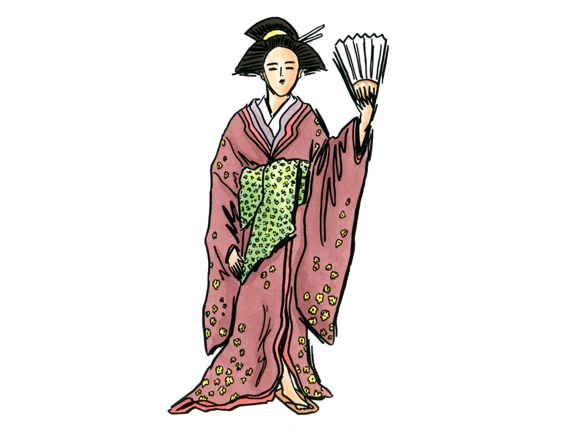Medieval Europe Feudal Japan Fashion Medieval Europe Feudal Japan Similarities Queens and Kings Emperor Shogun Daimyo Fashion style represented their class in the society Clothing depended on how wealthy they were Warriors wore protective battle wear instead of nice clothes. It would be worn with many other layers under the Kimono made with different.
A few centuries later the clog resurfaced in Europe as the 19th-century shoe of Dutch farmers.
. In fact many different types of people helped shape the medieval period. The women of the imperial court in Heian Japan 7941185 CE grew their hair as long as possible. Fashion Beauty Life In Heian Japan And Medieval Europe.
What did medieval Japanese people wear. Floral Designs such as blossoms with bright colours. For staying at home you would usually wear a.
Fashion and Clothing in Medieval Japan by churrio C. The kimonos for women included an obi which was a giant sash that they wrapped around their waist and was elaborately tied in the back. Pair by pair the clogs are coming out.
During the Medieval days in Japan clothing was the best part in dressing up and is still now today. Throughout much of the Middle Ages and in most societies the undergarments worn by both men and women didnt substantially change. FASHION - MEDIEVAL JAPAN.
Another development was the Japanese Tea Ceremony chanoyu which gained a much wider appeal thanks to the combined efforts of the monk Murato Shuko 1422-1502 CE and the shogun Ashikaga Yoshimasa r. Ad Order today with free shipping. People in feudal Japan wore kimonos.
The samurai wore woodblock pattern on their armor and their daily clothing. The Traditional Heian Japanese clothings worn then were kimonos which consisted if many layers and different materials like silks etc and many colours were used for their clothing considering the fact that they were very creative and loving for the different colours they could put into their cloths. These figures often seen in popular movies and games about pre-modern Japan are only loosely based on reality.
The peasants merchants and artisans wore rough kimonos made out of cotton. Medieval Japan may call to mind honorable sword-wielding samurai and stealthy ninja assassins. Would most likely wear them for.
Our Japanese pants and warrior kimono make a great choice for martial arts practice as well. The extravagant and richly embroidered costumes of the actors would greatly influence late medieval and early modern fashion in Japan. Darker Fabrics and more layers.
Shorter haori but for formal occasions you would wear a longer one. In the Japanese attire category you will find pieces for men and women ranging from elegant kimono to samurai clothing. This fashion began as a reaction against imported Chinese Tang Dynasty fashions which were much shorter and included ponytails or buns.
They wore it straight down their backs a shining sheet of black tresses called kurokami. It was also greatly influenced by the design of Japanese homesTraditional Japanese fashions that are still worn today include. Traditional Japanese fashion represents a long-standing history of traditional.
Clothing The Japenese have a rich and very unique fashion. Almost everyone in feudal Japan wore a kimono. Kimono was once worn on a daily basis by most Japanese people.
An everyday clothing for Japanese people would be called a Kimono. Japanese Fashion Line Releases New Samurai Wardrobe And It S. One of the most popular of these master pieces were the kimonos.
Dating back to the 13th century the clog was initially used as a wooden flip-flop in feudal Japan. The peasants merchants and artisans wore rough kimonos made out of cotton. They consist of long sleeves and go from shoulders to the heels.
Short History Of Japanese Textiles Silk may be the best known Japanese textile because of its stunning beauty and value for fashioning luxurious kimonos but in pre-industrial Japan only the nobility and upper classes were permitted to wear silk clothing. Women S Wear In Feudal Japan The Muromachi And Edo Eras Ppt. The upper class would wear elaborate kimonos made of silk.
Garments Worn Under Medieval Clothing. Materials and with different colours. A haori is a long and thin coat which was worn by men back in.
Patterns such as leaves. Two female and male Kimono outfits. There are typically two types of clothing worn in Japan.
Along with every era and culture Japan formed its own sense of fashion in the feudal era. In Medieval Japan men and woman would wear kimonos. Kimonos came during the Hein period 794CE - 1185CE.
Fashion Costumes of Medieval Japan - Free download as Powerpoint Presentation ppt PDF File pdf Text File txt or view presentation slides online. Feudal Japanese Fashion Google Search Japanese Fashion. The length of the haoris can change for the occasion you.
The pieces of clothing are suited to the seasons they are worn in. Feudal Japanese Fashion Google Search Chinese. Basically they consisted of a shirt or under-tunic stockings or hose and some kind of underpants or breeches for men.
Japan specialized with silk this silk was used to create some of the most beautiful pieces of tapestry and clothes known to the world. It was influenced by factors such as battle and the weather. Traditional clothing known as Japanese clothing 和服 wafuku including the national dress of Japan the kimono and Western clothing 洋服 yōfuku which encompasses all else not recognised as either national dress or the dress of another country.
Get the Deals now. Fashion Medieval Japan. Almost everyone in feudal Japan wore a kimono.
Times of Feudal Japan. Japanese Clothing Wikipedia. Japanese vests Japanese jackets and Japanese belts are all common items that can be paired with a variety of outfits.

Japanese Fashion Through The Eras From Heian To Heisei Tokyo Weekender

History Of Kimono The Edo Period Owlcation

Haori And Hakama Japanese Traditional Clothing Items Matcha Japan Travel Web Magazine

0 komentar
Posting Komentar